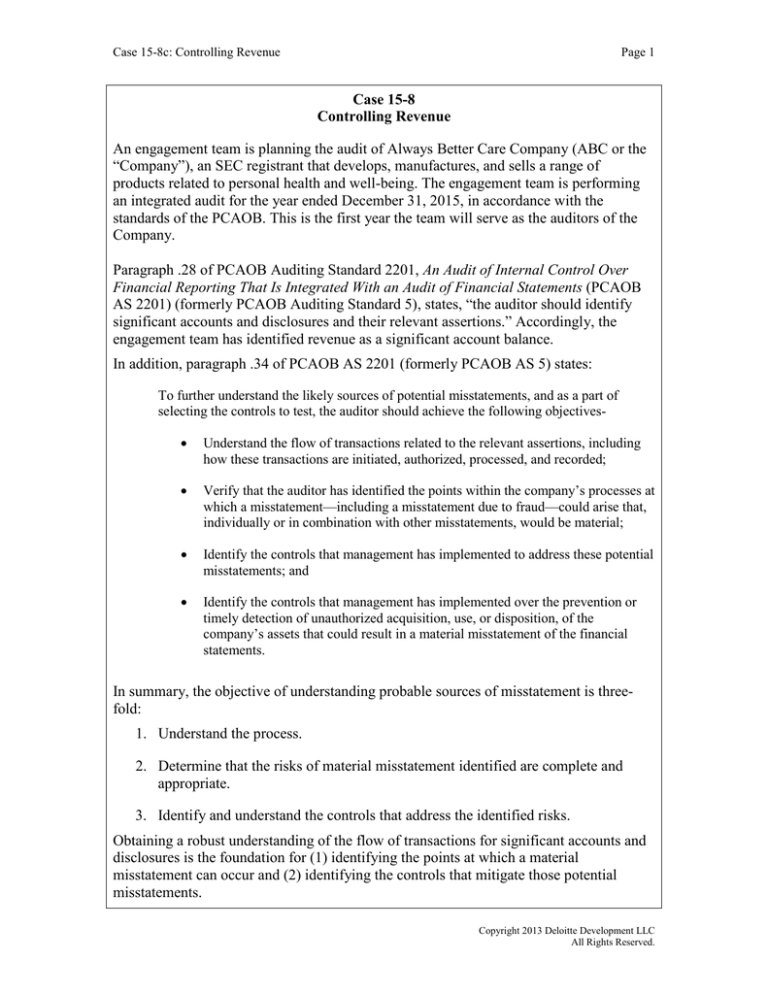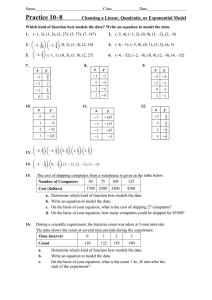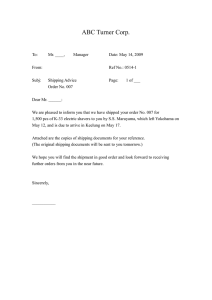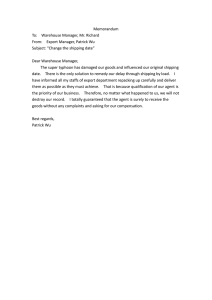
Case 15-8c: Controlling Revenue
Page 1
Case 15-8
Controlling Revenue
An engagement team is planning the audit of Always Better Care Company (ABC or the
“Company”), an SEC registrant that develops, manufactures, and sells a range of
products related to personal health and well-being. The engagement team is performing
an integrated audit for the year ended December 31, 2015, in accordance with the
standards of the PCAOB. This is the first year the team will serve as the auditors of the
Company.
Paragraph .28 of PCAOB Auditing Standard 2201, An Audit of Internal Control Over
Financial Reporting That Is Integrated With an Audit of Financial Statements (PCAOB
AS 2201) (formerly PCAOB Auditing Standard 5), states, “the auditor should identify
significant accounts and disclosures and their relevant assertions.” Accordingly, the
engagement team has identified revenue as a significant account balance.
In addition, paragraph .34 of PCAOB AS 2201 (formerly PCAOB AS 5) states:
To further understand the likely sources of potential misstatements, and as a part of
selecting the controls to test, the auditor should achieve the following objectives•
Understand the flow of transactions related to the relevant assertions, including
how these transactions are initiated, authorized, processed, and recorded;
•
Verify that the auditor has identified the points within the company’s processes at
which a misstatement—including a misstatement due to fraud—could arise that,
individually or in combination with other misstatements, would be material;
•
Identify the controls that management has implemented to address these potential
misstatements; and
•
Identify the controls that management has implemented over the prevention or
timely detection of unauthorized acquisition, use, or disposition, of the
company’s assets that could result in a material misstatement of the financial
statements.
In summary, the objective of understanding probable sources of misstatement is threefold:
1. Understand the process.
2. Determine that the risks of material misstatement identified are complete and
appropriate.
3. Identify and understand the controls that address the identified risks.
Obtaining a robust understanding of the flow of transactions for significant accounts and
disclosures is the foundation for (1) identifying the points at which a material
misstatement can occur and (2) identifying the controls that mitigate those potential
misstatements.
Copyright 2013 Deloitte Development LLC
All Rights Reserved.
Case 15-8c: Controlling Revenue
Page 2
To obtain an understanding of the flow of transactions in the revenue of ABC, the
engagement team has obtained a revenue process narrative and revenue process flow
diagram from the Company (see Handout 1).
Process flow diagrams are a tool we can use to depict the process to initiate, authorize,
process, record, and report transactions; the points within the process at which
misstatements could occur; and control activities that are designed to prevent or detect
such misstatements, including providing greater transparency to segregation of duties.
These diagrams also depict the relevant systems and information produced by the entity.
Below is an excerpt from ABC’s revenue process narrative and process flow diagram.
For this excerpt, only two of the five sub-processes are included: (1) order processing and
(2) shipping and invoicing (sales returns, payment processing, and monitoring of
accounts receivables have been excluded).
Revenue
Order Processing
Orders are received via fax, mail, e-mail, or phone. Customer service associates (CSAs)
are responsible for monitoring incoming orders that arrive at the business center. All
faxes and postal mail are electronically converted by CSAs and input into the system.
Telephone orders are directed to a central call number and an available CSA takes the
order information.
All orders must be created with reference to a customer account that is established in the
customer master file within SAP, the Company’s information technology system. If an
order is received for a nonexisting account, the new-account procedure is followed
whereby a credit analyst reviews the credit worthiness of the customer on the basis of a
Dun & Bradstreet credit report. When credit is denied, the order process ends and the
customer is notified of the credit decision. If credit is extended, a credit analyst creates a
new customer account in the customer master file and requests that a CSA process the
order.
When an order is entered in SAP, “sold to” and “ship to” fields must be populated with a
valid customer number that matches the established customer number in the customer
master file. Fields for sales and payment terms are automatically populated with the
information contained in the customer master file in SAP. All line items on the sales
order are systematically populated based on the information in the master pricing file.
Sales orders are configured with the following mandatory fields: sales order type (e.g., a
rush order or a stock order), order source (e.g., fax, mail, e-mail, phone), sales
organization, sold-to and ship-to account numbers, item quantities, material numbers, and
purchase order number. The balance of the information is automatically extracted from
the customer master file or pricing master file records. Sales to customers with
Copyright 2013 Deloitte Development LLC
All Rights Reserved.
Case 15-8c: Controlling Revenue
Page 3
nonstandard payment or shipping terms are automatically flagged in SAP; the flags are
used in the shipping and invoicing process to generate exception reports for management
review. Pricing for each customer may differ on the basis of negotiated contracts, which
are configured against the master pricing file with customer-specific discounts applied.
When orders are placed on hold because of an account or credit hold, the credit
department is notified. A credit analyst will review the hold and determine whether the
hold can be resolved. If the hold cannot be resolved, the credit analyst will notify the
customer of the order cancellation, thus ending the order-entry process. If after an
investigation the hold can be resolved, the credit analyst will release the hold and submit
the order to a customer service manager for review. All processed orders must be
reviewed and approved by a customer service manager before they are submitted for
shipping and invoicing. If errors are discovered, they are resolved by the CSAs and the
order is resubmitted through the process. After a sales order is approved, it is released
and updated in SAP.
Shipping and Invoicing
After a sales order is approved, the data is transferred automatically from the order entry
system to the shipping and invoicing modules in SAP. Outgoing inventory lists are
printed by the stockroom personnel. Outgoing inventory list quantities are populated
systematically based on information defined in the approved sales orders.
The product ordered is pulled from the warehouse by shipping personnel according to the
information defined on the outgoing inventory lists. The shipping personnel will verify
the information, such as item and quantity, and package the item for shipment.
After the order is prepared for shipment, the shipping personnel prepare a bill of lading
including the carrier information using a pre-numbered bill of lading form. The bills of
lading are on carbon paper which contain multiple copies of the bill of lading. Shipments
of goods to customers are logged; this is completed by using carbon copies of the prenumbered bill of lading documents and manually entering information from the bill of
lading document in a spreadsheet that is maintained by shipping clerks. The spreadsheet
is referred to as the “orders shipped log.” Another copy is forwarded to shipping data
entry personnel who confirm the order as shipped, thus completing the shipping process
within the system.
Once an order is marked as shipped, line items in the sales order will change
automatically in the system, which will result in closing the shipped lines and staging of
the line items to be invoiced. Only the lines on the sales order that ship will be invoiced.
Open lines are back-ordered and will remain open until those items are shipped. The only
other way to close a line on an order is to reject the line, which requires approval by a
customer service manager.
Each day, the SAP system compiles the staged invoices in a daily open invoice report.
The orders shipped log and the daily open invoice report are reviewed by the warehouse
Copyright 2013 Deloitte Development LLC
All Rights Reserved.
Case 15-8c: Controlling Revenue
Page 4
director daily to verify that all orders shipped have also been included in the invoicing
batch. The warehouse director compares the shipments recorded on the daily open
invoice report to the shipments logged on the manual orders shipped log as being shipped
to a customer. If differences are noted, the warehouse director works with shipping
personnel to ensure shipments are recorded in the system accurately. If no differences are
noted, the batch is approved in SAP for invoice processing.
The warehouse director’s review consists of the following steps:
•
The warehouse director verifies that all bills of lading for a specific day are
included in the orders shipped log. This verification is performed by comparing
the ending pre-numbered bill of lading from the prior day to the start of the prenumbered bills of lading for the current day and then comparing the ending prenumbered bill of lading for the current day to the bill of lading detail to verify that
the last pre-numbered bill of lading for the date was properly included. This step
ensures that all numbers in the sequence are properly accounted for.
•
The warehouse director reconciles the daily open invoice report to the daily orders
shipped log and verifies that all shipments listed in the orders shipped log were
also listed in the daily open invoice report for the same day.
•
The warehouse director evidences his review by writing check marks (or some
other form of indication) beside each reconciled customer shipment listed on the
reports and by signing and dating the reports upon completion of his review.
•
When any discrepancy exists as a result of his reconciliation of the daily open
invoice report and the orders shipped log, the warehouse director writes an “X”
(or some other form of indication) beside the line item and investigates the
discrepancy.
•
For each discrepancy, the warehouse director works with shipping personnel to
resolve the difference. Documentary evidence is obtained to support the
resolution of the difference.
Invoicing is performed nightly via SAP through a systematic batch process. The SAP
system performs a three-way match; invoices can only be processed when there is a
systematic matching of the purchase order and bill of lading/shipped status, completing a
three-way match to generate the invoice. The invoice generation process (1) updates the
general ledger, (2) records the sale (recognizes the revenue) and the receivable, (3)
relieves the inventory, and (4) records cost of goods sold. As part of the nightly batch
process, the SAP system generates a report that lists every flagged transaction that
contains nonstandard sales or shipping terms; this report is called the “nonstandard
transaction report.”
Revenue is recognized at the time of invoicing because the Company’s standard sales
terms are defined as free on board (FOB) shipping point. At the end of the month, an
accounting manager reviews all daily nonstandard transaction reports that were generated
Copyright 2013 Deloitte Development LLC
All Rights Reserved.
Case 15-8c: Controlling Revenue
Page 5
during the month; any nonstandard sales terms (e.g., FOB destination) are reviewed in
detail to ensure sales are classified properly under GAAP. If corrections are necessary,
the accounting manager makes manual adjustments to reflect proper GAAP classification
of the transaction. After nonstandard terms are reviewed, the accounting manager
samples 50 sales transactions to evaluate the coding, supporting documentation, and
journal entries made to the general ledger for all sales that are booked; any nonstandard
coding is reviewed in detail and resolved to ensure sales are classified properly under
GAAP. If corrections are necessary, the accounting manager makes appropriate manual
adjustments to reflect proper GAAP classification of the transaction.
Refer to Handout 1 for the Order Processing and Shipping & Invoicing Process Flow
Diagrams.
Required:
1. What are the relevant controls that address the risks in the order processing subprocess within the revenue process for ABC?
2. What relevant control identified would address the risk that goods are shipped to
customers but no invoice is generated and recorded?
3. When considering the audit procedures outlined in PCAOB Auditing Standard
2301, The Auditor’s Responses to the Risks of Material Misstatement (formerly
PCAOB AS 13), and PCAOB Auditing Standard 1105, Audit Evidence (formerly
PCAOB AS 15), what are the audit procedure or combination of audit procedures
that may be performed to test the operating effectiveness of the relevant control
identified in Question 2 above?
Copyright 2013 Deloitte Development LLC
All Rights Reserved.



